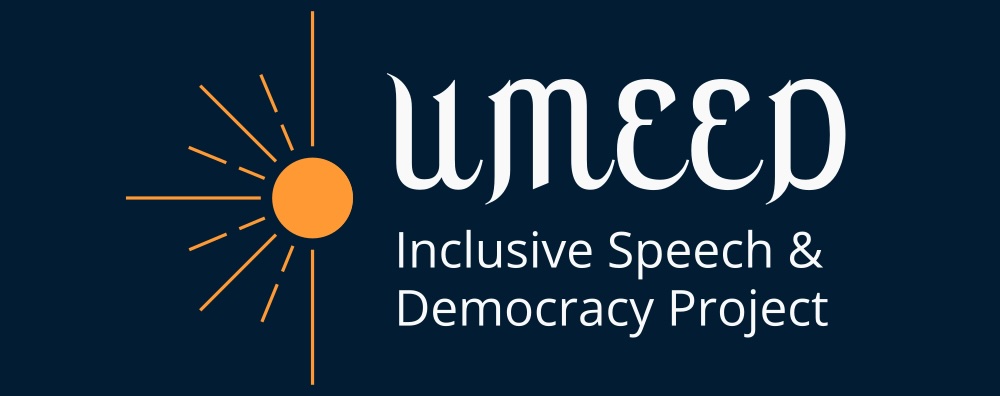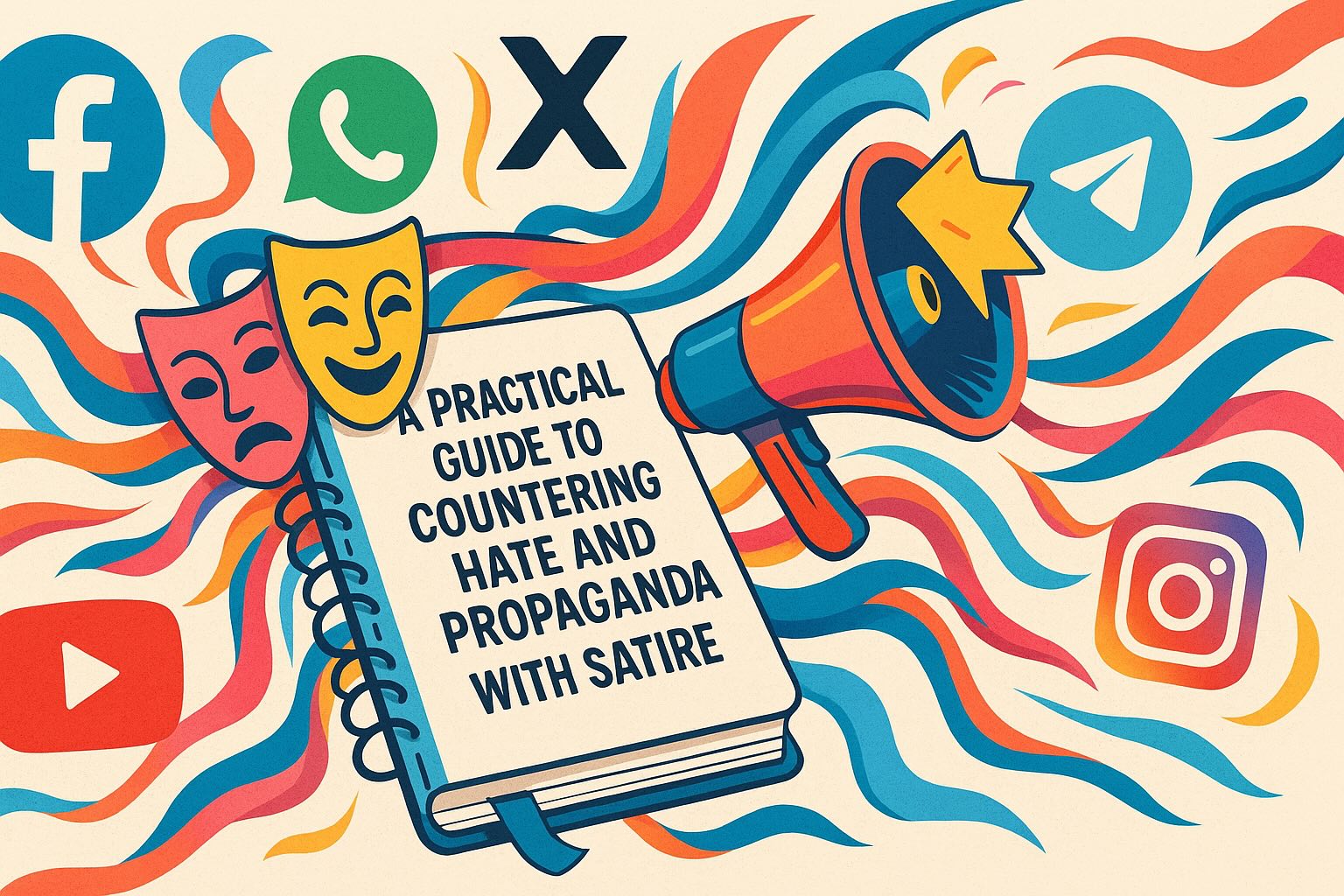The Savala Vada (TSV), a satirical Instagram page run anonymously, publishes a mix of bold graphics and sharply written captions to counter hate speech and disinformation. In this interview with one of its co-founders, we explore the essential steps and resources for creating satire that serves as a counter-narrative to hate and propaganda.
Umeed: What first steps should someone take if they want to create satirical content to counter hate speech?
TSV: The first step is to stay thoroughly informed: your satire can only cut through if it’s grounded in current events and accurate context. It’s equally important to understand who you’re speaking to and who you want to reach: craft your satire so that even those who initially disagree feel compelled to engage. Given the fleeting nature of online attention, lead with a clear, punchy hook that makes your main point obvious at a glance, then provide deeper context in accompanying captions or follow-up slides. Building an audience will take time. Our page grew steadily over a year and a half. So, perseverance is key and every misstep is simply a lesson that helps you improve. As you develop a core following, look for ways to expand beyond your base by translating popular posts, collaborating with creators in other spaces, or adapting your format for different platforms. Finally, remember to practice self-care. The online world can be overwhelming, so schedule breaks and set healthy boundaries to avoid burnout before you’ve had a chance to make a lasting impact.
Umeed: What skills or resources would you recommend for someone aiming to create effective satirical content in the counter–hate-speech space?
TSV: On the technical side, start by mastering basic design and editing tools—Canva for graphics, Premiere Pro or free alternatives for video, and simple audio-editing software if you plan to add voice overs. These platforms are surprisingly accessible, and there are countless tutorials on YouTube to get you up to speed. If you’re more comfortable with writing or drawing, exploring comic-strip tools or even pen-and-ink sketches can be just as powerful. The key is to leverage whatever medium plays to your strengths.
Beyond the tools, strong research habits are indispensable. You need to stay current on news and understand the context behind each story you satirize. That background knowledge gives your work depth and credibility.
Of course, you need creativity and a good ear for humor—knowing how to spot irony in real events and turn it into a clear, punchy narrative. Studying classic satirists, from Monty Python to local literary giants, can help you learn timing, tone, and structure.
Finally, persistence and passion are essential. Building an audience takes time, and you’ll make mistakes along the way. Treat each post as a learning opportunity, iterate based on feedback, and keep challenging yourself to refine both your craft and your message. With dedication and the right mix of skills, anyone can start using satire to challenge harmful narratives.
Umeed: What advice would you give creators on maintaining anonymity and ensuring personal safety when tackling sensitive, controversial issues through satire, especially in a country where dissent is criminalized?
TSV: Anonymity is crucial in our ecosystem. We only revealed one team member’s voice during a recent Swaddle podcast appearance—otherwise, we stay behind the curtain. You can choose to go public—some pages do and accept the risk of doxing—but anonymity dramatically reduces those threats, even though no measure can eliminate risk entirely.
Use secure tools. A privacy-focused email like ProtonMail, a reliable VPN (though free options in India can be scarce), and always mask your location. Minimize your digital footprint by keeping separate accounts for personal and satirical work, and never reveal identifying details in your posts or metadata.
Remaining anonymous protects not just you but also your relationships and creative autonomy. If power knows exactly who you are, it can silence you, or pressure you into self-censorship. In an environment of heightened surveillance, anonymity lets you speak truth to power without fear of immediate reprisal and keeps outside pressures from influencing your content.
Umeed: What do you think about collaborations? How important are partnerships in amplifying counter–hate-speech work or is it better to work in silos?
TSV: Collaborations are crucial. They let you tap into demographics and skills you don’t have in-house. In a moment when repression targets every sector, forging alliances against a common threat is essential. Instagram makes these partnerships easy—cross-posting stories, co-hosting live sessions, tagging each other—but real impact goes beyond any single platform. No person, page, or organization can do it all alone. Every collaboration strengthens the bridge between communities and expands the reach of counter-hate narratives.
Umeed: What would you recommend, whether at an individual or organizational level, for anyone looking to address hate speech? Any must-read publications, creators, or tools?
TSV: I’d begin by immersing yourself in reputable news and reporting outlets that delve into South Asian and global issues—publications like The Caravan, The Quint, Scroll, and Wired offer in-depth analysis, while regional platforms such as Maktoob Media provide critical on-the-ground perspectives. To understand effective satire, study global exemplars like The Onion and John Oliver, then observe how Indian comedy creators on YouTube and Instagram tackle politics and social norms with humor and insight. For rigorous background, turn to academic research via Google Scholar: look up studies on hate speech, propaganda, and digital media, and practice translating those dense findings into accessible posts or visuals. Video essays offer another powerful model—channels like Philosophy Tube and ContraPoints demonstrate how to blend analysis with engaging storytelling, and emerging Indian essayists are producing similarly thoughtful deep dives on caste, identity, and media narratives. Finally, arm yourself with basic design and editing skills—tools like Canva or free video editors will let you craft compelling graphics and clips—and don’t shy away from open-access repositories such as LibGen or the Internet Archive to source books and reference materials. Ultimately, your toolkit will evolve through continuous learning, following diverse voices online, and experimenting across formats—text, image, video, or audio—to find the methods that best amplify your counter–hate-speech message.

